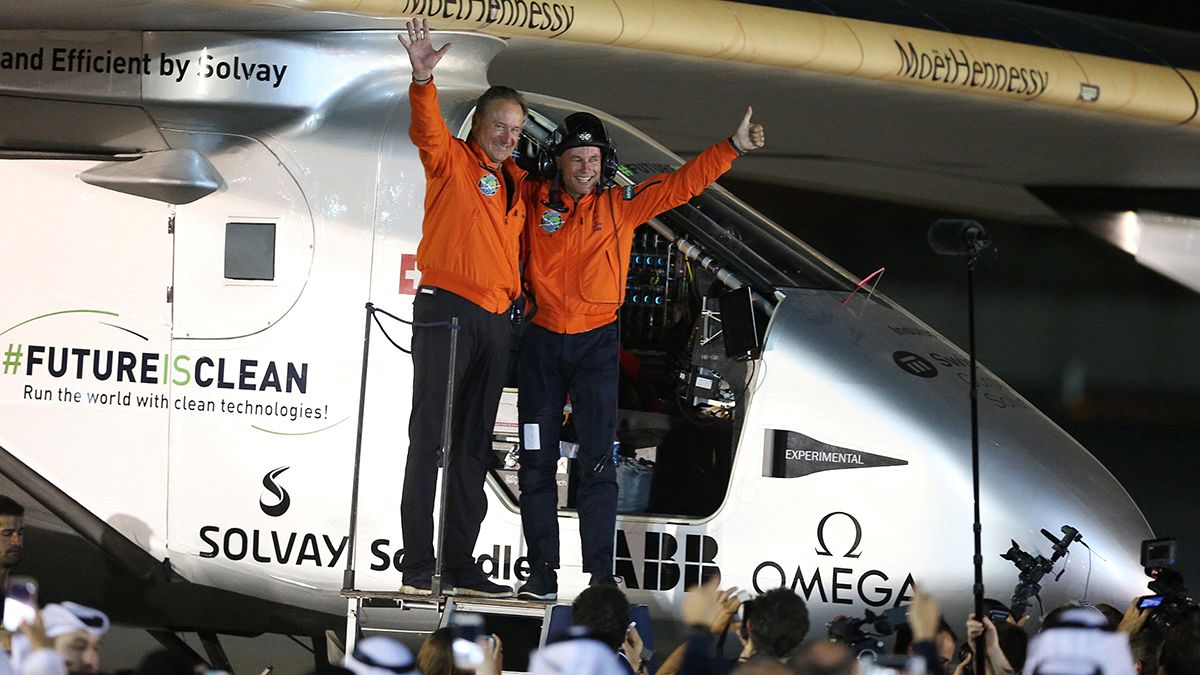Solar Impulse 2 has completed the first around the world flight using nothing but the sun's energy.
Solar Impulse 2 has completed the first around the world flight using nothing but the sun’s energy.
After it landed in Abu Dhabi there were celebrations for Andre Borschberg and Bertrand Piccard, the two Swiss pilots who had taken turns flying the solar cell encrusted plane.
Euronews reporter Rita del Prete, who witnessed the touch down, said this was the fulfilment of a dream: “This historic world tour by an airplane ‘fuelled’ only by solar energy is not just an aviation triumph. It is also a victory for the challenge of the use of renewable energies on a global scale.”
BREAKING: we flew 40'000km without fuel. It's a first for energy, take it further! #futureiscleanpic.twitter.com/JCvKTDBVZx
— SOLAR IMPULSE (@solarimpulse) July 26, 2016
Piccard, who was at the controls for the final leg of the journey, told Euronews the plane has made “history in energy” and they will now build on that achievement: “I want to set up an international clean technologies council, because right now that doesn’t exist and there’s no way for people from the world of ‘cleantech’ to work together to gain a bit more power, to speak with one voice and to influence governments.”
The journey began in March last year but after nearly 500 hours of flying time on a journey of about 40,000 km (24,500 miles), Piccard said they have demonstrated clean technology is viable: “Our partners not only paid for the project, but also made the technology possible, and with our efforts we made it work and heading for the market, so that Solar Impulse was able fly day and night without fuel. And that is what the world needs.”
The propeller-driven aircraft’s four engines are powered by energy collected from more than 17,000 solar cells built into the wings. Excess energy is stored in batteries.
There were 16 stops and many delays as the huge but very light aircraft had to be nursed through difficult weather conditions. It was grounded for months in some countries.
Completing a 13-year exploit is perhaps the biggest #challenge we now face #futureiscleanhttps://t.co/9DABXSg8AGpic.twitter.com/UrVZ0ZMOpX
— SOLAR IMPULSE (@solarimpulse) July 26, 2016
Piccard – who in 1999 was the first person to go round the world non-stop in a hot air balloon – expressed pride that they had proved the impossible was doable: “When you simply break a record, you just beat someone who has already done it, you try to do better, but you know the thing is possible. When you achieve a first (like this), you don’t know if it’s possible, no one has ever done it before. I think that was the main motivation for our team, and for all the people who have followed us, to see how we could achieve something that was considered impossible by the experts. And that’s why today I am so happy to have shown that it was possible.”
10 videos from the round-the-world #solar flights that will give you goosebumps: https://t.co/Jxf51RfIjmpic.twitter.com/x2JV5lfnb8
— SOLAR IMPULSE (@solarimpulse) July 26, 2016
